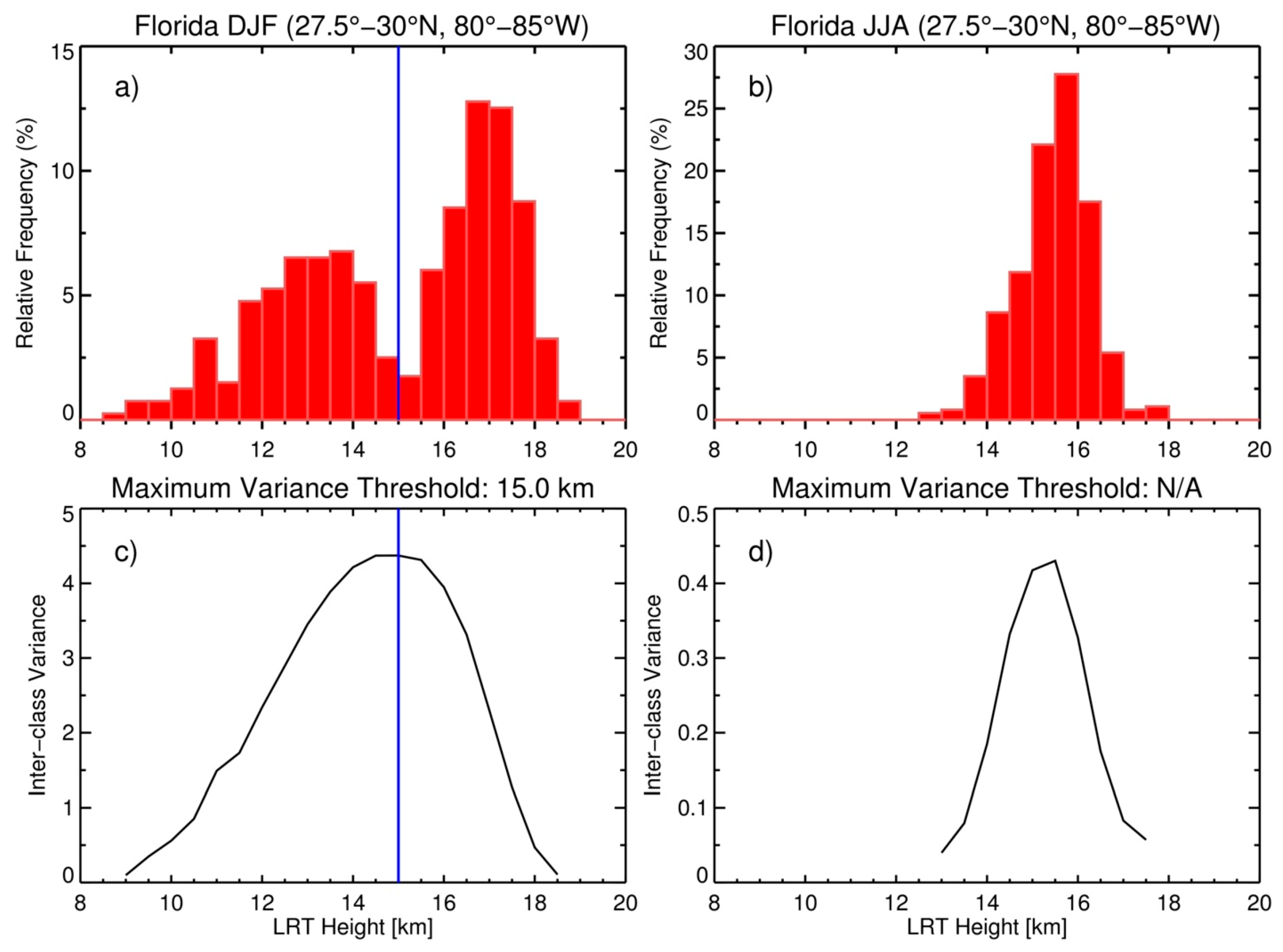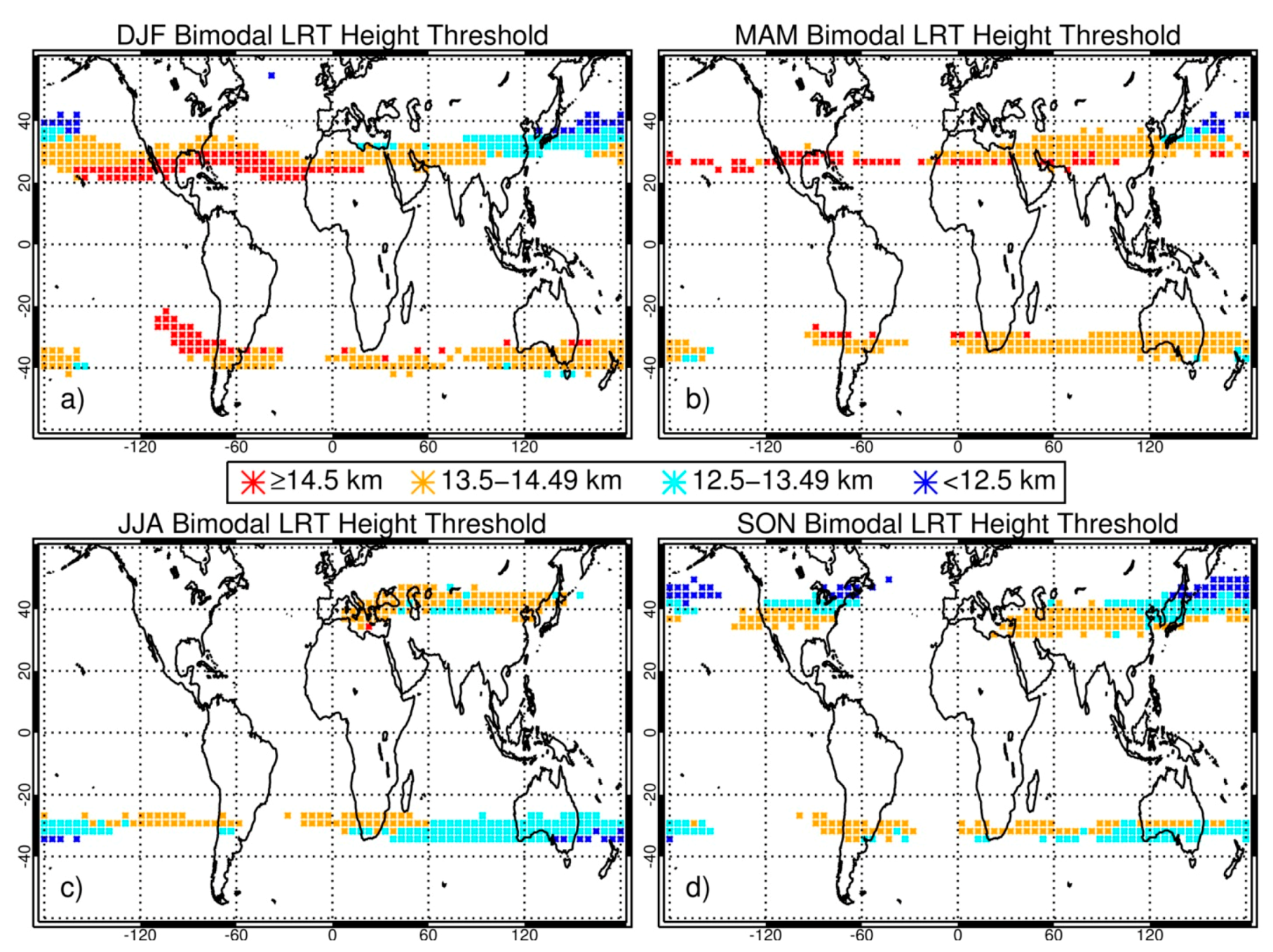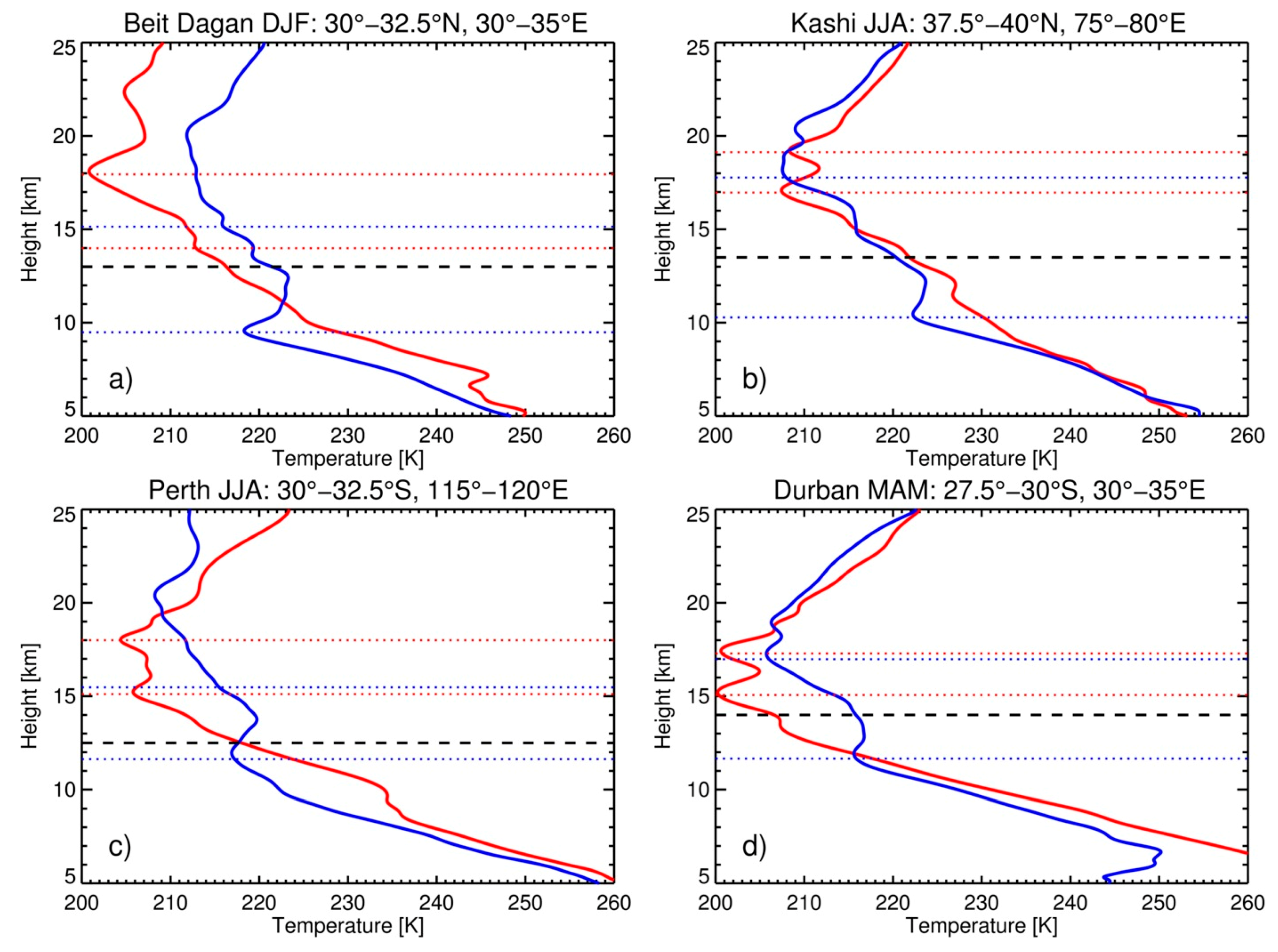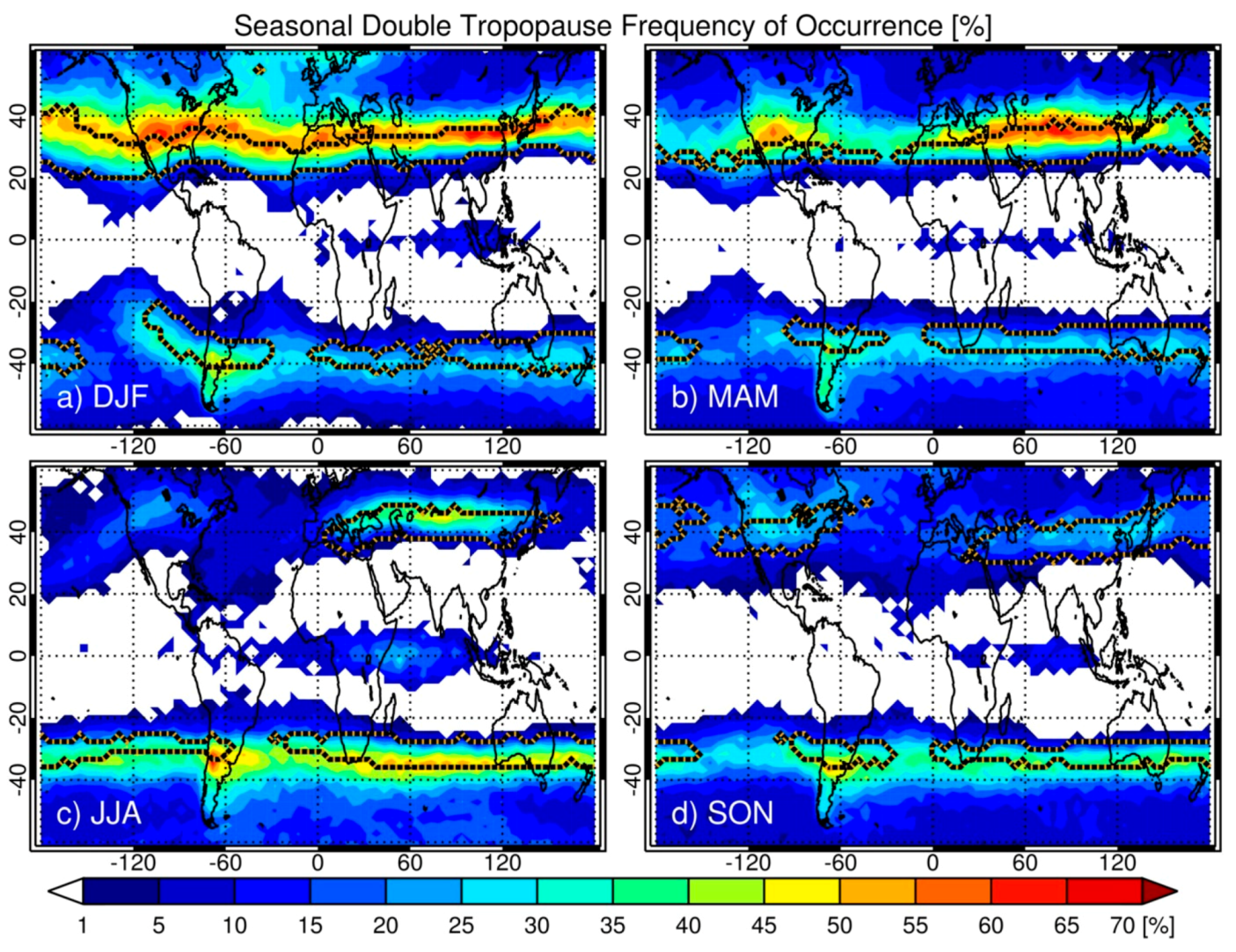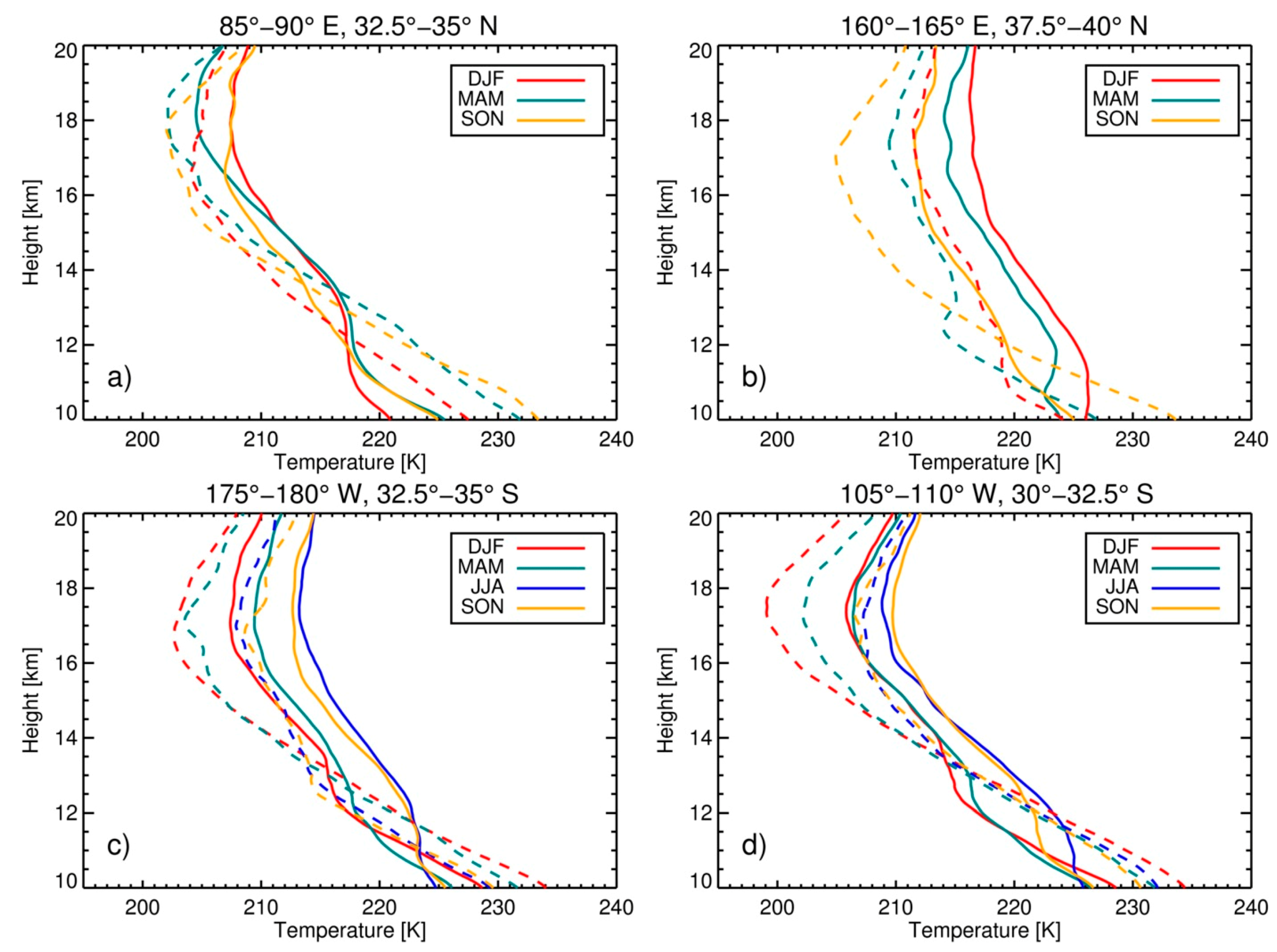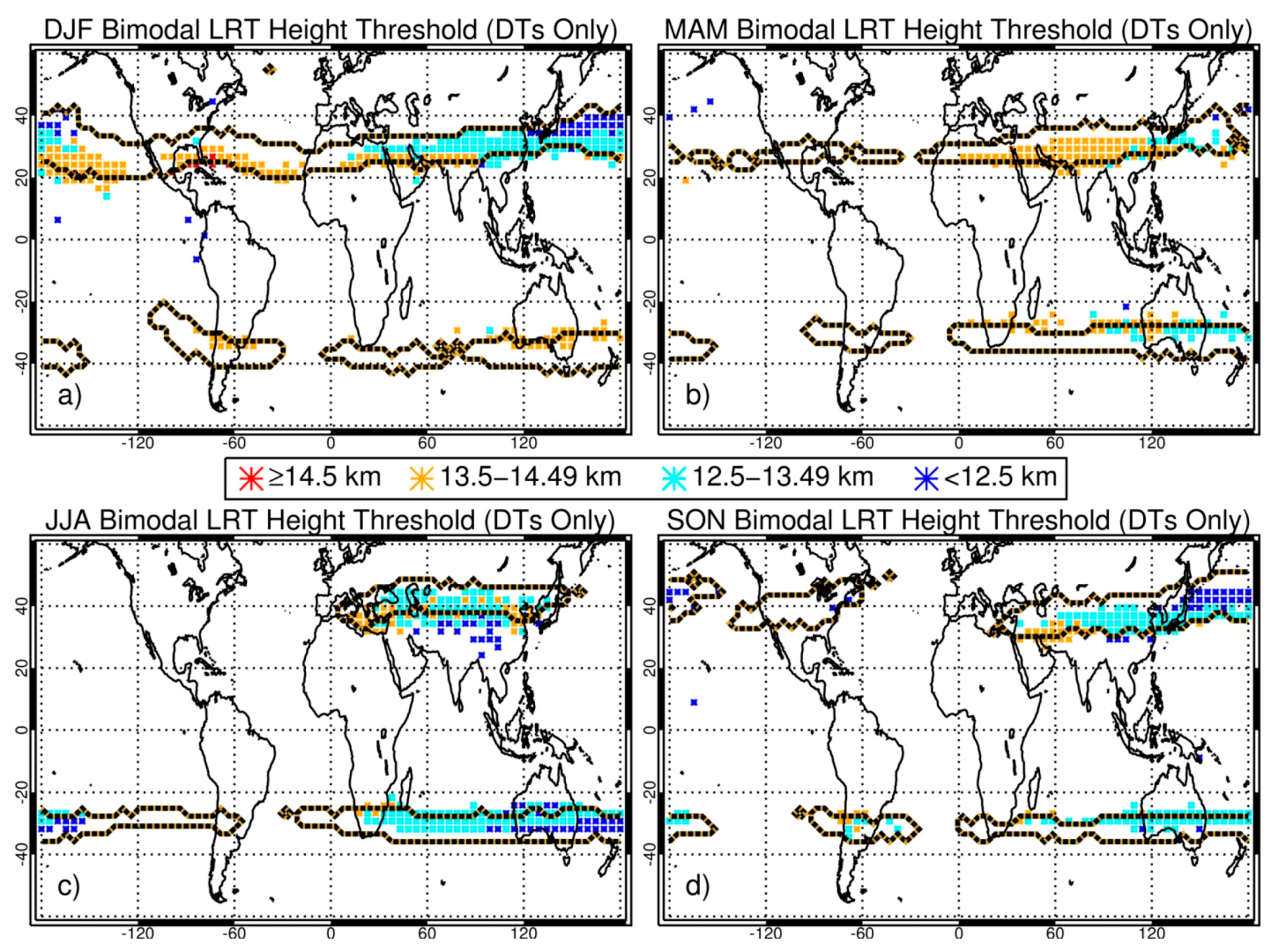3.1. Bimodal Tropopause Locations and Characteristics
This section examines the bimodality of the extratropical tropopause by determining where and when bimodality occurs and what the characteristics are of each mode. Seidel and Randel [
15] (hereafter SR2007) used radiosonde data from 1979 to 2005 along with collocated NCEP/NCAR reanalysis data to demonstrate the occurrence of bimodal LRT heights at four different subtropical radiosonde stations. However, their analysis does not address the seasonal variation of bimodality.
Figure 2 displays the seasonal probability density functions (PDFs) of COSMIC LRT heights at four grids close to the SR2007 radiosonde stations. The LRT heights are binned using 1-km intervals from 5 to 20 km. A distinct seasonality in LRT heights is observed in each region. In Beit Dagan (
Figure 2a), bimodality occurs in DJF and March–April–May (MAM) with very similar PDFs, as there are two well-defined peaks with deep valleys in between. However, bimodality is not evident in JJA and September–October–November (SON). Large peaks occur above 15 km (characteristic of the tropical tropopause) during these seasons with less frequent occurrences of the lower tropopause heights. For Kashi (
Figure 2b), seasonality is also observed but with opposite characteristics. Bimodality is now only observed in JJA and SON, with JJA displaying the larger peak for the higher (tropical) tropopause heights, whereas the larger peak during SON is observed for the lower (extratropical) heights. In contrast, heights throughout DJF and MAM are almost exclusively of the extratropical variety. This difference between Beit Dagan and Kashi can be attributed to the differences in latitude, as Kashi is much farther north and experiences extratropical heights more frequently. At Perth (
Figure 2c), bimodality is observed in three seasons (MAM, JJA, and SON). In JJA, the total occurrence frequency of each mode is very similar, whereas MAM and SON are skewed toward the tropical heights. The results at Durban (
Figure 2d) are comparable, as bimodality is also observed in MAM, JJA, and SON with similar modal characteristics displayed. COSMIC LRT heights show considerable seasonal variability for the occurrence of bimodality. Each location experiences large differences in the occurrence frequency of the tropical and extratropical mode, and these variations occur due to seasonal variations in the location and strength of the subtropical jet [
18].
The next set of figures expands upon bimodal tropopause features by showing when/where tropopause bimodality occurs globally and what the characteristics are.
Figure 3 maps the seasonal locations of bimodal tropopauses along with the altitude that separates the two modes (the bimodal threshold). In general, bimodality occurs more frequently during the winter due to a stronger subtropical jet and temperature contrasts [
3]. In DJF (
Figure 3a), bimodality occurs in the Northern Hemisphere continuously throughout, on average, an approximately 10°–20° wide band between 20° and 40° with considerable zonal variations due to the location of the subtropical jet. Bimodality in the Southern Hemisphere generally displays a width of approximately 10° and demonstrates much less meridional movement, except off the western coast of South America. The bimodal threshold is generally highest in DJF, with many locations on the equatorward side of the band experiencing threshold values above 14.5 km. This occurs because the tropical tropopause heights are typically highest in DJF (approximately 17 km) and lowest in JJA (approximately 16 km) [
24]. Substantial bimodal threshold differences occur in the Northern Hemisphere DJF, with ranges reaching 3 km or more between the northern and southern edges of the band in the Northern Pacific. In MAM (
Figure 3b), the Northern Hemisphere bimodal band begins to shrink in extent throughout the Western Hemisphere, with most of the occurrence relegated to the North American continent along with threshold values remaining high (≥14.5 km). However, occurrence remains similar to DJF throughout the Eastern Hemisphere or even increases in extent over the Asian continent. The Southern Hemisphere bimodal band characteristics are almost identical to DJF except for a slight shift equatorward (approximately 5°) and a reduction in the tropical “tail” off the west coast of South America. In JJA (
Figure 3c), the only remaining bimodal region throughout the Northern Hemisphere is over continental Europe and Asia. This region is much farther north (generally between 40° and 50°) and is likely associated with the Asian monsoon circulation. The Asian monsoon circulation includes a strong anticyclonic flow in the UTLS, and double tropopauses frequently occur on the poleward flank of this anticyclonic circulation (the region of westerly zonal winds), where the tropical tropopause (near 16 km) extends poleward to almost 60° [
3]. As a result, bimodal thresholds remain relatively high (mainly between 13.5 and 14.49 km) even at these higher latitudes. In the Southern Hemisphere winter, the zonal extent of bimodality remains relatively similar to the other seasons, although the bimodal threshold is generally lower. In general, bimodality occurs more frequently in the Northern Hemisphere winter, similar to the double tropopause frequencies shown in Peevey et al. [
18]. This is likely due to hemispheric differences in land–ocean distribution [
19]. The number of large mountain ranges in the Northern Hemisphere enhances the propagation of large wavenumber 2 waves, which can influence the development of double tropopauses [
18]. In SON (
Figure 3d), the Northern Hemisphere bimodal extent begins to increase, especially throughout the Western Hemisphere (such as over the northern United States). The location continues to remain at relatively higher latitudes (exclusively poleward of 30° and up to almost 50°), and height thresholds are dependent on latitude.
Within each grid that observes bimodal LRT heights shown from
Figure 3, the occurrence frequency for COSMIC profiles with LRT heights within the lower mode is shown in
Figure 4. As expected, the modal frequency of occurrence displays a distinct shift within each band of bimodal LRT heights within all seasons, as the equatorward side of the band typically has fewer profiles with LRT heights within the lower mode (<40% occurrence), whereas the poleward side has more within the lower mode (>60%). This shift occurs relatively quickly (over the course of 2.5°–5° latitude) due to the characteristic “tropopause break” that occurs at this latitude, as the tropopause dips rapidly from the tropics to the extratropics. Double tropopauses occur frequently around this region as well. These features are also associated with the characteristic break in the LRT near the subtropical jet where the tropical tropopause extends to higher latitudes, overlying the lower extratropical tropopause [
3]. Thus, the observed LRT bimodality, especially along the equatorward side of the bimodal region, may be related to these double tropopause environments and is investigated further in the next section.
3.2. Relationship of Double Tropopauses to the Occurrence of LRT Bimodality
This section will investigate the relationship between double tropopauses and bimodality. First, it is beneficial to demonstrate typical DT temperature profiles to understand the types of synoptic environments present.
Figure 5 shows individual profiles with DTs from the same four locations discussed in
Figure 2 (Beit Dagan, Kashi, Perth, and Durban) during specific seasons whenever bimodality occurs. There are two types of profiles shown for each location: the blue profile is when the first tropopause height (LRT1) is below the bimodal threshold, and the red profile is when it is above the threshold. In Beit Dagan (
Figure 5a) and Perth (
Figure 5c), the profiles are obtained from the winter, while the profiles for Durban (
Figure 5d) are obtained from the fall. For all three locations, the two profiles look considerably different. The DT profiles with LRT1 heights in the lower mode (LM) all have LRT heights below 12 km. A strong inversion occurs just above LRT1 and is known as the tropopause inversion layer, which is a region of enhanced static stability above the extratropical tropopause associated with a narrow-scale temperature inversion [
34]. This layer can be as shallow as 1 km (such as near Durban) or as thick as 4 km (such as near Beit Dagan). Then, above this layer, the temperatures begin to decrease again (albeit at a different lapse rate compared to below the first tropopause) until reaching a second tropopause near the typical tropical tropopause height (e.g., 17 km near Durban). In contrast, the DT profiles with tropopause heights in the upper mode (UM) display a much warmer upper troposphere (up to 5 K). However, temperatures quickly become colder above the LM profile’s first tropopause, and the UM profile’s tropopause is generally 5–10 K colder. This indicates that two different types of environments are present (tropical versus extratropical). Additionally, two summer profiles are shown for Kashi (
Figure 5b) that look very similar, but with large differences in the strength of the inversion around 10–11 km. The inversion is strong and well-defined in the LM profile but is not strong enough in the UM profile to be classified as a tropopause according to the WMO definition. We speculate that these differences could be due to the previously discussed Asian monsoon circulation. The strength of the anticyclonic circulation and associated westerly winds likely influence the type of profile observed, as a stronger circulation would produce a stronger inversion (and vice versa).
It is necessary to display double tropopauses characteristics to understand how these events relate to bimodal tropopause height distributions.
Figure 6 shows the seasonal double tropopause frequency of occurrences along with the locations that display bimodal LRT heights. Double tropopause frequencies are generally highest in the winter in each hemisphere, as NH DJF (
Figure 6a) shows a large area of frequencies >50% (with some values between 60% and 70%) along the poleward edge of the bimodal region, and SH JJA (
Figure 6c) also displays a few areas with >50% occurrence frequencies. These values decrease slowly through the seasons, with NH minimum frequencies occurring in SON and SH minimum frequencies occurring in MAM (generally <35%). Additionally, frequencies decrease rapidly toward the equatorward edge of where bimodality occurs, as many locations observe frequencies <20%. Overall, the COSMIC RO locations of DTs agree well with previous research, although our frequencies are slightly lower than those found by Schmidt et al. [
19], who saw maximum frequencies over 80% in some locations, and slightly higher than those of Peevey et al. [
18], who generally saw frequencies up to 50%. Both studies relate the high frequency of DTs in the subtropics to the zonal mean wind speeds at 200 hPa, as the maximum zonal wind at this altitude serves as a rough indicator for the mean location of the jet streams [
18,
19]. The bimodal region is generally close to the regions that experience a high frequency of DTs. However, the regions do not display a perfect overlap, as the highest DT frequencies often continue poleward beyond where bimodality was identified for up to 5°–10°.
It is also useful to establish the type of environments most frequently associated with the formation of DTs and how the LRT1 forms in these profiles.
Figure 7 shows the percentage of DT profiles that have their LRT1 height within that grid’s lower mode. Similar to
Figure 6, there is a distinct meridional shift in the percentage of profiles that have their LRT1 within the lower mode. For example, in DJF (
Figure 7a), DT profiles on the poleward edge of the NH bimodal band almost always have a lower (extratropical) LRT1 height, as most grids display values of >80% (and some percentages are as high as 95%). In contrast, many grids on the equatorward edge of the bimodal band observe percentages of <50%. This indicates that the LRT1 for DT profiles at these latitudes can also occur at altitudes consistent with the tropical tropopause. Additionally, there are strong zonal asymmetries in the Northern Hemisphere, as latitudes such as 30° show considerable longitudinal structure (e.g., percentages in Southeastern Asia are <50% compared to the Eastern Pacific percentages of >80%). This same pattern is evident in every Northern Hemisphere season. Less variation is evident in the Southern Hemisphere as most grids observe frequencies of >65%, except in JJA (winter) and SON (spring). This result shows that not all DT environments are the same. While most DTs do produce LRT1 heights of extratropical origin (in the lower mode), sometimes DT profiles can have LRT1 heights within the upper mode. Even though most locations on the equatorward side of the bimodal band have smaller DT occurrence frequencies (generally <35%), these profiles would play a considerable role in producing tropopause bimodality in these locations.
The previous figure indicates that not all temperature profiles with double tropopauses are identical. Even though most DT profiles do have their LRT1 within the lower mode (e.g., of extratropical origin), there are still some with their LRT1 within the upper mode. Characterizing the different structures of these two types of DT profiles is important in analyzing their synoptic environments and how DTs contribute to bimodal LRT height distributions.
Figure 8 shows the gridded seasonal mean temperature profiles for double tropopause profiles with LRT1 heights within the lower mode (solid lines) and the upper mode (dashed lines). Two Northern Hemisphere and two Southern Hemisphere grids were chosen based on bimodality occurring throughout most or all of the year to allow for more seasonal comparisons. Bimodality does not occur year-round in any Northern Hemisphere grids (so locations with only three bimodal seasons, sans JJA, were chosen), whereas it does occur year-round in a few Southern Hemisphere grids. Two different types of double tropopause synoptic environments are apparent for each location. In
Figure 8a, profiles with lower mode DT profiles look very similar throughout all seasons, with LRT1 heights generally between 11 and 12 km and second tropopause (LRT2) heights near 17–18 km. In contrast, the upper mode DT profiles in this region look more like single tropopause tropical profiles as the finer scale features are smoothed out in the mean profiles, but little variation is evident again between the seasons. The lower mode profiles are generally 5–10 K colder throughout the upper troposphere but generally become approximately 5 K warmer above the lower mode profile’s LRT1. More seasonal variation is evident in
Figure 8b, as both the lower mode and upper mode mean profiles display large temperature differences at all altitudes along with LRT height locations. Both Southern Hemisphere locations (
Figure 8c,d) display profile characteristics that look relatively similar. For example, the LM and UM mean profile temperature magnitude, LRT1 heights, and profile shape are almost the same in each season. In summary, these profiles provide additional evidence that there are considerable differences among DT profiles depending on their LRT1 altitude, and these differences provide insight as to which large-scale environment is influencing the location at each time (tropical versus extratropical).
Furthermore, COSMIC profiles in the study region are classified by whether they have single or double tropopauses in order to establish how the LRT height bimodality changes for each type of profile and help determine which type of profile plays a larger role in producing bimodality in different locations. Bimodality is shown for DT profiles in
Figure 9 along with the bimodal threshold height. In general, the bimodal band is slightly reduced in extent relative to the results shown for all profiles (e.g.,
Figure 3), although in some locations, its occurrence is eliminated almost completely (such as over North America in SON). Bimodality generally occurs toward the equatorward side of the previously identified bimodal region, as now large portions of bimodality between 30° and 40° are not observed. The bimodal threshold is generally lower for DT grids in locations that overlap with bimodal grids observed from all profiles, as the threshold is typically one category lower (e.g., up to 1 km lower). This indicates that DT profiles often result in lower bimodal thresholds, since their LRT1 heights are typically lower than the LRT1 height of single-tropopause profiles, even when both profiles are extratropical in nature.
Finally, we determine where tropopause bimodality occurs when considering temperature profiles that only have a single tropopause identified along with the bimodal threshold height in
Figure 10. The bimodal band becomes much narrower when examining single tropopause profiles, as its maximum width is generally only 2.5°–7.5° and shows many additional gaps. The location is shifted toward the poleward edge of the previously identified bimodal region throughout all seasons. For example, in DJF (
Figure 10a), the NH band is confined between 30° and 40° whereas before, many locations also observed bimodality between 20° and 30°. This shift toward the poleward edge continues for all seasons and both hemispheres, and in some locations, the single tropopause bimodal band shifts poleward slightly beyond the bimodal band displayed for all profiles. At the same time, the bimodal threshold is generally higher for single tropopause-only grids in locations that overlap with bimodal grids from all profiles, as the threshold is often one category higher (e.g., up to 1 km).
